TPO -> TPOs of Great Britain - The Beginning
TPOs of Great Britain - The Beginning
By Rick Martin
The story of the TPO (Travelling Post Office) begins in England in 1838.
 A Travelling Post Office was a railway wagon, van or coach that is fitted out with frames
(known as "pigeon holes") to sort letters and other mail items while the train is on the move.
A Travelling Post Office was a railway wagon, van or coach that is fitted out with frames
(known as "pigeon holes") to sort letters and other mail items while the train is on the move.
Although Rowland Hill (who gave the United Kingdom, and subsequently the rest of the world, the idea of affordable postage for letters) claims that he had thought of on board sorting of the mails in horse drawn mail coaches in the 1820s, it was George Karstadt, a provincial Post Office Surveyor, who first proposed the idea of fitting out a railway carriage as a travelling sorting office. His son, Frederick, together with Edward Ellis and Henry Mellersh, were the first Post Office clerks to sort the mails while they were in transit on the newly opened railway between Birmingham and Warrington (Lancashire).
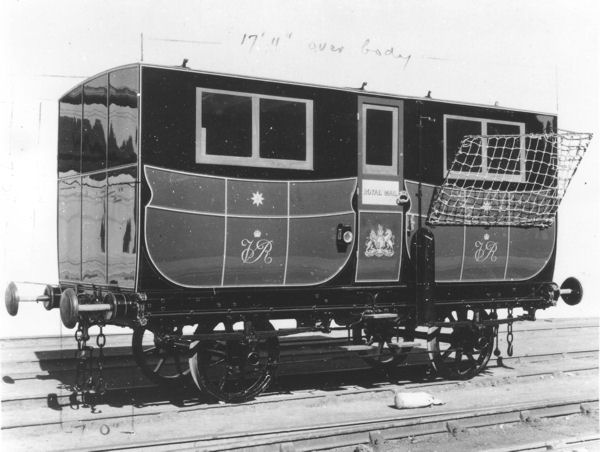
The first TPO was a four-wheeled horse box converted for the occasion and it ran in January 1838 attached to the 07.00 train from Birmingham every morning, returning in the afternoon. The time of the journey was 3½ hours and provided connections at Birmingham with the night mails to and from London, which were still carried by horse drawn Mail Coaches. The temporary TPO was soon replaced by a 20 foot (6m) custom built vehicle, and several more were built to be used on night services.
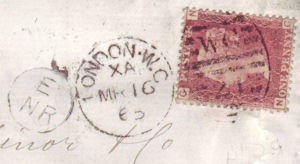 After the completion of the railway between London and Birmingham in September 1838, a TPO ran from London through to Warrington.
Originally known as the Grand Northern Railway Post Office, this TPO was the precursor of the North Western TPO Night Down,
which eventually (in 1923) became the Down Special TPO. From these humble beginnings the British Travelling Post Office
network began and became the basis for similar operations in countries around the world.
After the completion of the railway between London and Birmingham in September 1838, a TPO ran from London through to Warrington.
Originally known as the Grand Northern Railway Post Office, this TPO was the precursor of the North Western TPO Night Down,
which eventually (in 1923) became the Down Special TPO. From these humble beginnings the British Travelling Post Office
network began and became the basis for similar operations in countries around the world.
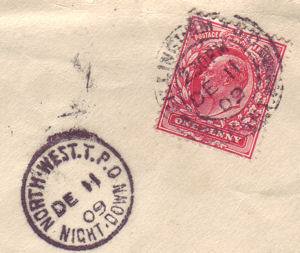 The TPO service grew very quickly in the succeeding years with the expansion of the rail network in England and Scotland, and the railway
companies provided new bigger purpose built vehicles as part of mail carrying contracts agreed with the Post Office.
The TPO service grew very quickly in the succeeding years with the expansion of the rail network in England and Scotland, and the railway
companies provided new bigger purpose built vehicles as part of mail carrying contracts agreed with the Post Office.
After the introduction of Penny Postage in May 1840, the quantity of mail handled by the TPOs rose sharply; (until this time the postage for a letter was charged by the number of miles it had been carried), now the postage was charged by weight. By 1852 TPOs ran from London, to Perth in Scotland, to Exeter in the West Country, and to Newcastle Upon Tyne in the North East. There were also cross-country TPOs between Bristol and Newcastle. TPOs were also set up to handle foreign mails from ships calling at Plymouth (Plymouth & Bristol TPO (Foreign Mails)) and Queenstown (London & Holyhead (United States Mail)) to list just two. They often ran as part of other regular TPOs, such as the London & Holyhead T.P.O - Night Down.
There is no difference. The Tenders / Carriages were managed under Area Postmasters, rather than from TPO HQ which came later, and they chose their own descriptions - hence Great Northern Railway Post Office, Cornwall Railway Sorting Tender etc. etc. says TPO Journal Editor Keith Morris. Here is a rare sorting carriage example.
Until 1854 the TPO service and its staff had been under the control of the Mail Coach Office, the Post Office department that at one time looked after the running of the horse drawn Mail Coaches. By 1867, the TPOs were sufficiently important to have their own Department, headed by a "Surveyor of Travelling Post Offices", who now had over 200 staff under his control.
The TPO service reached its peak in the British Isles in the years before 1914. There were then over 130 TPOs running between the major cities, with connecting Sorting Carriages (SC) providing country areas with an excellent delivery service. TPOs came under the Control of the Superintendent of TPOs in London; SCs were controlled by Provincial Postmasters from where they began their initial trip (e.g. The Lincoln SC was under the supervision of the Postmaster in Lincoln.) The Railway Magazine article "The Night Mails at Crewe in 1923" provides a view of mail operations at a busy railway junction.
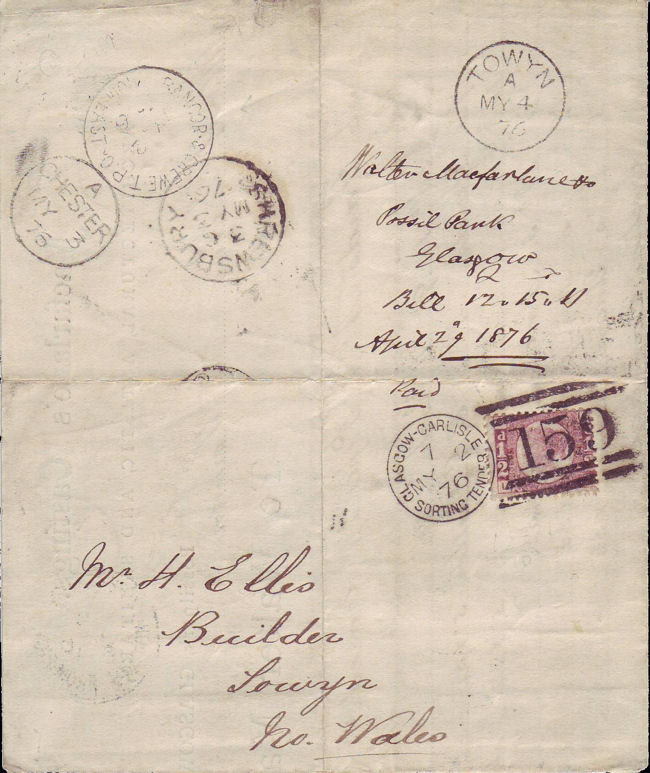
A missent entire from Macfarlane's Castings, Possilpark, Glasgow, posted on to the Glasgow - Carlisle Sorting Tender (Wilson type 731) on 2nd May 1876 and addressed to Mr H Ellis of Towyn, North Wales. Its journey included a trip on the Bangor & Crewe TPO / Going East (W137b) on 2nd May 1876 before receiving Chester and Shrewsbury strikes on the 3rd May 1876. It arrived at its destination on the 4th May 1876.
In 1940 all 72 mainland TPOs and SCs and the 4 TPOs running in Northern Ireland were withdrawn. After 1946 with the gradual restoration of the TPO network, (and the nationalisation of the railway network), many daytime and some of the cross-country TPOs were not re-instated.
You may view a Diagram of the GB TPO Network as of 1958 here.
Faster trains, improved roads for the movement of mail and transit of mail by air meant that the British TPO system finished in 2004. Britain was almost the last European country to operate a TPO network. TPOs in Belgium, Germany, France, Netherlands and the Scandinavian countries had all ceased in the years between 1975 and 2000.
Mail bag exchange apparatus
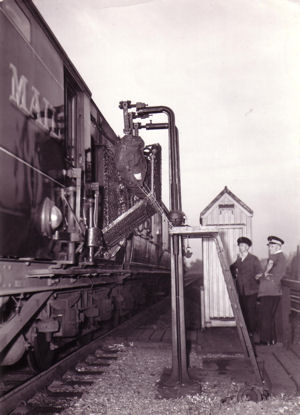 An operation almost unique to British TPOs was the dropping and picking up of mailbags while the train to which the TPO was attached
travelled past the pick up point at anything up to 80 miles per hour (128kph). The bags, weighing from 20 to 50 pounds (10-23kg),
were attached to a folding bracket, (the traductor), and swung out from the side of the TPO to be caught in a net on the ground,
at the same time bags would be hung from a line side pole (the standard) to be caught up in a net that was extended from the side of the TPO.
Early experiments took place on the first TPO in 1838, but it was not until 1852 that a final design was agreed between the Post Office and
the various railway companies. John Dicker was an Inspector of Mail coaches, and his modification of an existing design remained in
use from 1852 until 1971, when the last exchange of mailbags took place at Penrith in Cumbria.
An operation almost unique to British TPOs was the dropping and picking up of mailbags while the train to which the TPO was attached
travelled past the pick up point at anything up to 80 miles per hour (128kph). The bags, weighing from 20 to 50 pounds (10-23kg),
were attached to a folding bracket, (the traductor), and swung out from the side of the TPO to be caught in a net on the ground,
at the same time bags would be hung from a line side pole (the standard) to be caught up in a net that was extended from the side of the TPO.
Early experiments took place on the first TPO in 1838, but it was not until 1852 that a final design was agreed between the Post Office and
the various railway companies. John Dicker was an Inspector of Mail coaches, and his modification of an existing design remained in
use from 1852 until 1971, when the last exchange of mailbags took place at Penrith in Cumbria.
Around the World
In other countries around the world, the TPO was variously known as "Railway Post Office" or RPO (in North America); "Ambulante" in Spanish speaking countries; "Amb" or "Ambulant", (France and French speaking territories); "Bahnpost" (Germany and Austria); "Jernbanebureau", "Postekspedisjon", "Jernvagens postkupéexpedition" "Postkupéer" (Denmark, Norway, Finland and Sweden respectively). Virtually every country that had a railway network had a TPO service of one kind or another.
Mail Guards / Mail Guard Marks
In 1838 Parliament passed the first Conveyance of Mails Act, under which the Postmaster General was given power to call on the Railway Companies to convey his "Mails and Guards" in all trains.
It was accepted for many years that Mailguard handstamps were supposedly issued to guards on trains to use on correspondence handed to them on route, or, as a missort on TPOs. However, about the late 1840s to early 50s railway companies began providing letter boxes at railway stations for the benefit of customers and staff. In London it was felt that there was a need to provide name stamps for each individual box, after all there were only five and the handstamps could be held at the Chief Office for application to mail when it was brought in from the letterboxes. The GWR refused to participate in the GPO station letter box scheme hence no GW mailguard marks were ever recorded. Source – Railway Philatelist Volume 39 No 3.

An example is this entire life policy questionnaire sent to Bermondsey in 1856. On the reverse is mail guard mark "South E Ry." in red. Once completed, the questionnaire was posted back to Standard Life using a second penny red for postage. A superb piece of postal history.
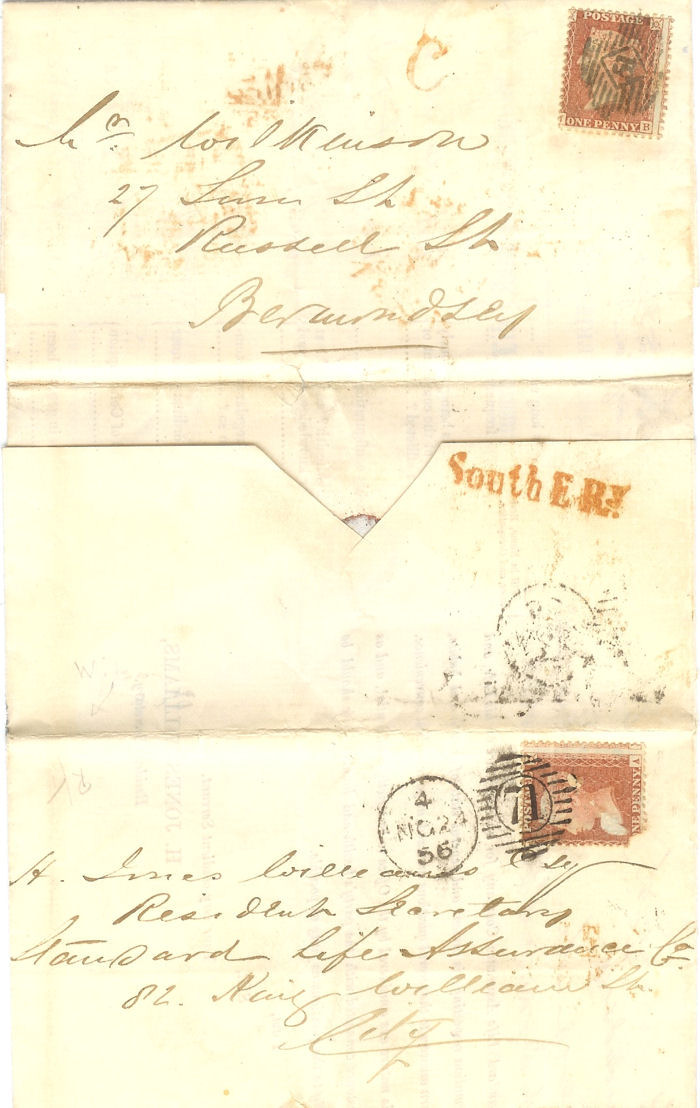
Bibliography:
Travelling Post Offices & Bag Tenders of Great Britial & Ireland, An Operational History from 1839 to 1959, (typescript dated February 1960)
Allan Harvey, TPO & Seapost Society, 2000.
TPO Postmarks of Great Britain 1962-1990 (including supplements), R Stubbs and GP Roberts, TPO & Seapost Society.
Irish mail, Cyril Kidd, TPO & Seapost Society 1996.
TPO Postmarks of the British Isles, Norman Hill, 1962.
TPO - A History of the Travelling Post Offices of Great Britian, Part 3. Scotland and Ireland, H S Wilson, 1977.
Refer also to the TPO & Seapost Society Library.
Resources
View the British Postal Museum Archive (BPMA) article about the TPO.
View the TPO Network of Great Britain in 1958

